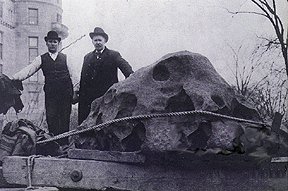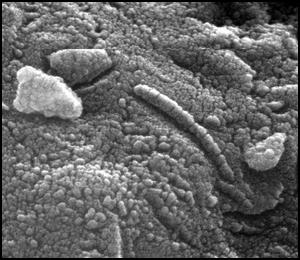Meteorite

A meteorite is a small extraterrestrial body that impacts the Earth's surface. While in space they are called meteoroids, and while falling through Earth's atmosphere they are called meteors. Most of them were small asteroids, approximately boulder-sized or less. Some meteorites have come from the Moon and Mars. When it enters the atmosphere, air resistance causes the body to heat up and emit light, thus forming a fireball or shooting star. More generally, meteorites fall on every solid planetary body, creating craters such as those on the Moon. Meteorites are so far the most important materials for studying planetary science.
Population
79 percent of meteorites are chondrites - balls of mafic minerals with small grain size, indicative of rapid cooling. In most chondrites, small spherules called chondrules can be found. Chondrites are typically about 4.6 billion years old and are thought to represent material from the asteroid belt. There are different models to explain how chondrules formed. Carbonaceous chondrites, some of which are thought to be unaltered solar nebula material, constitute about five percent of meteorites and contain small amounts of organic materials, including amino acids. Also, presolar grains are identified in carbonaceous chondrites. The isotope ratios of carbonaceous chondrites are similar to those of the Sun.
Achondrites are similar to terrestrial mafic igneous rocks and sometimes are brecciated. Achondrites constitute about eight percent of the incoming material and are thought to represent crustal material of some of the larger asteroids and occasionally Moon or Mars. About six percent of meteorites are iron meteorites with intergrowths of iron-nickel alloys, such as kamacite. Unlike chondrites, the crystals are large and appear to represent slow crystallization. Iron meteorites are thought to be the core material of one or more planets that subsequently broke up. Stony iron meteorites constitute the remaining two percent. They are a mixture of iron-nickel and silicate minerals. They are thought to have originated in the boundary zone above the core regions where iron meteorites originated.
Classification
Meteorites are classified according to their structure and mineral composition. The three main classes of meteorite are stones, stony irons, and irons. Each chondrite is described using the following two-character group name and a petrologic type. Starting from the most primitive type 3, decreasing numbers (2~1) indicate higher degrees of aqueous alteration, and increasing numbers (4~7) indicate degrees of thermally metamorphism.
- Stones
- Chondrites
- Carbonaceous chondrites: CI (Ivuna), CM (Mighei), CV (Vigarano), CO (Omans), CK (Karoonda), CR (Renazzo), CH (High iron), CB (Bencubbinites)
- Ordinary chondrites: H (High iron), L (Low iron), LL (Low, low iron)
- E (Enstatite) chondrites: EL (Low iron), EH (High iron)
- R (Rumuruti) chondrites
- K (Kakangari) chondrites
- Achondrites
- HEDs: Howardites, Eucrites, Diogenites
- Lunar
- Martian
- Primitive achondrites: Acapulcoites, Lodranites, Brachinites, Winonaites
- Others: Angrites, Aubrites, Ureilites
- Chondrites
- Stony irons: Pallasites, Mesosiderites
- Irons: IAB, IC, IIAB, IIC, IID, IIE, IIF, IIG, IIIAB, IIICD, IIIE, IIIF, IVA, IVB
Notable meteorites
- Heat Shield Rock - Found on Mars.
- Orgueil meteorite - Object of a 1965 hoax that involved embedding a seed within part of the meteorite.
- Murchison meteorite and Allende meteorite - These CM2 and CV3 chondrites fell in 1969 and greatly contributed to meteoritics and planetary science.
- Canyon Diablo meteorite - Used by pre-historic Native Americans.
- Sikhote-Alin Meteorite - Massive impact event that occurred on February 12, 1947.
- ALH84001 - Mars meteorite that was claimed to prove the existence of life on Mars.
- Kaidun meteorite - Possibly from the martian moon Phobos.
- Tagish Lake meteorite - Possibly from a D/T-type asteroid or comet.
See also
External links
All links retrieved April 29, 2025.
Credits
New World Encyclopedia writers and editors rewrote and completed the Wikipedia article in accordance with New World Encyclopedia standards. This article abides by terms of the Creative Commons CC-by-sa 3.0 License (CC-by-sa), which may be used and disseminated with proper attribution. Credit is due under the terms of this license that can reference both the New World Encyclopedia contributors and the selfless volunteer contributors of the Wikimedia Foundation. To cite this article click here for a list of acceptable citing formats.The history of earlier contributions by wikipedians is accessible to researchers here:
The history of this article since it was imported to New World Encyclopedia:
Note: Some restrictions may apply to use of individual images which are separately licensed.
